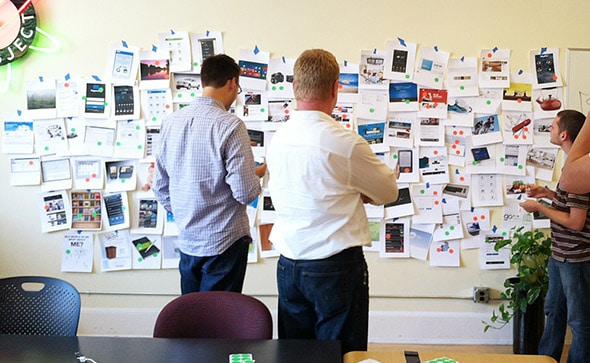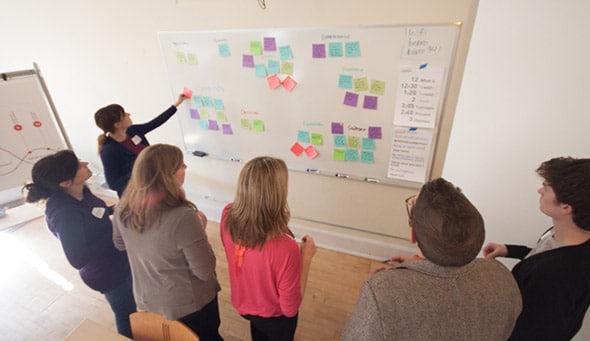Atomic Object is hiring software designers to add to our teams in Grand Rapids, Ann Arbor, and Detroit. We’re a great company to work for, with competitive pay and benefits. Here’s how to apply.
I’ve been a designer at Atomic Object for almost three years now, and I love what I do. My colleagues and I are continuously working to build, grow, and improve a thriving design culture at our company.
Design culture is a tricky thing. It doesn’t just happen, especially when you’re trying to build it within an existing company. Whether that company is a software development company like ours, a startup, or an established business looking to enhance their offering through good design, you need to be purposeful about creating an environment where all facets of design — from divergent thinking, user research, and concept investigation, through visual design, user experience, and implementation — are supported and valued. Adding a few Nerf guns and trendy posters won’t cut it — a company that’s truly supportive of design will experience a culture shift from the inside out.
In this post, I’m going to talk about 5 characteristics of our company, and how they contribute to fulfillment, happiness, and success in my career as a designer. In sharing these characteristics, I’d love to spark conversation and reflection within other companies and among the community at large.

1. We collaborate continuously.
Through a lot of experimentation and iteration, Atomic Object has adopted a highly-successful poly-skilled teams approach to building software. We have no “design department” or “development department”; instead our organization is made up of product teams: flexible groups of designers, developers, and testers who are tasked with solving a problem.
As a designer working on product teams, there is a cadence of collaboration that happens throughout the day and the week as we work together to design and implement a software solution. Rather than creating some comps and “throwing them over the wall” to a development team, I work in sync with my teammates, getting valuable input from people whose perspective differs from mine, and constant feedback about feasibility and viability of the work I’ve produced. Through regular weekly and quick ad-hoc design critiques, I also get input from the designers at Atomic who belong to other product teams.
Working closely with others has two very important effects that have greatly enriched my career: it creates a shared sense of purpose and daily opportunities for teaching and learning.

2. We deliver great products.
Here’s a frustration I have heard from all kinds of designers, many times over: “I delivered a great concept, but by the time business/engineering/development/(insert outside force here) got done with it, the design was ruined.” As a designer at Atomic Object, I very rarely end up in situations like this, because I am directly involved in building the products I design.
Designers at Atomic participate throughout a project’s lifecycle, from the time a client comes with a concept for something they want to make, all the way through to implementation and user acceptance testing. We do great design thinking and also have a beautiful portfolio of finished work. We collaborate with developers on UX implementation and front-end code, allowing us to ensure that visual and interaction design is implemented to the correct specifications.
If a design needs changes or if compromises need to be made because of technical limitations or business reasons, designers are involved in that process too, so that we can provide insight and help make the best possible decision.

3. We have direct access to the people who matter.
Besides my product teams, there are two other categories of people who have a huge impact on my happiness as a designer: my clients and my leaders. I’m quite a fortunate designer because I have direct access to both.
When a designer doesn’t have direct access to a client and their work is filtered through other people, such as a creative director or a project manager, frustration is almost always the result. As a designer at Atomic Object, I present my own work directly and engage in an active dialog with the client about the design of their product. Talking directly with my clients, I have the ability to communicate the reasoning behind design decisions, educate them about the design process, and hear direct, unfiltered feedback about my work. More often than not, this results in an extremely positive, enjoyable working relationship, rather than the “Ugh, clients, amiright?” feeling that many designers experience.
Similarly, due to Atomic’s flat management structure, I have great working relationships with and direct access to Shawn and Mike, who are the Managing Partners of my office. Any time I have a question, a concern, or an idea for something to try, I can go to them confidently and know that my thoughts will be taken seriously.
4. We don’t have titles.
At Atomic, there are no creative directors or senior designers. We’re all just designers… and in a way, we’re all creative directors, responsible for producing the best work possible on our own projects and giving the best feedback possible on our colleagues’ work. In practice, not having titles takes away the artificial idea of a ladder that needs climbing and puts the focus where it should be: producing great work and making the biggest impact possible on our clients, their products, and our company.

5. We have room to grow, innovate, and be challenged.
At Atomic, our designers (and developers) are all generalists. Nobody specializes in a particular technology (such as Ruby or .NET or iOS), discipline (such as UX or IA or Graphic Design), or part of the process (such as business development, early research, or implementation). We participate in all parts of the process, beef up our skills on the fly where necessary, and regularly consult our colleagues who may have more expertise in one area or the other. In our organization, there is always something to learn, somebody to learn from, and something that you can teach other people.
Atomic is a learning organization, which means we are constantly innovating on our processes and iterating and growing on ourselves. In practice, if this means that if one of us has an idea for something to try, either as part of a project, or something that will grow the company, and a well-reasoned rationale for doing it, then it’s pretty much open season.
Conclusion
I feel that one blog post can’t possibly cover all aspects of this topic. A thriving design practice requires purposeful engagement from leadership, designers, and other members of the organization, and one size does not fit everyone. In sharing these stories about our company, I hope I’ve sparked ideas or thoughts in your head about ways you and your organization could learn and grow. I would also love to hear about characteristics that I haven’t included in this list.
What does a thriving design culture mean to you?
Does all of this sound great to you? Do you want to work for us? Then you should probably apply right now. Due to our culture and practices, Atomic Object is a great place to work if you’re a designer who wants to excel in your field and make a difference on the world.
If you’re already working at an organization that you love, here’s a takeaway for you: these practices aren’t proprietary! Many of the characteristics and practices I’ve mentioned above can be applied to any organization or team (some of them more easily than others). So choose something and try it out… and let me know how it works!
